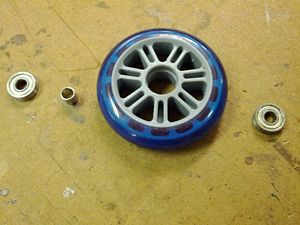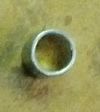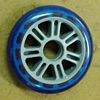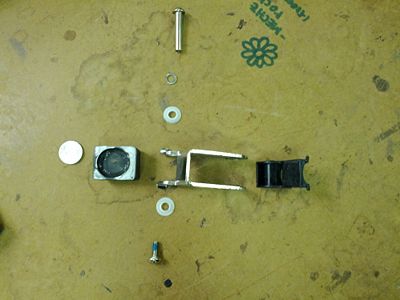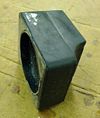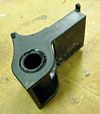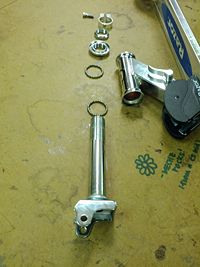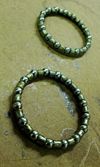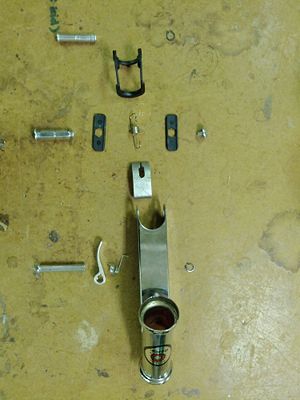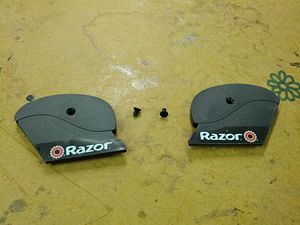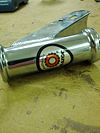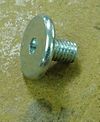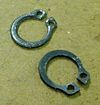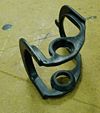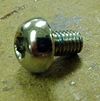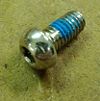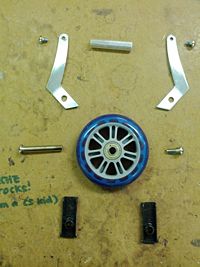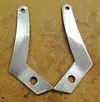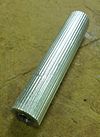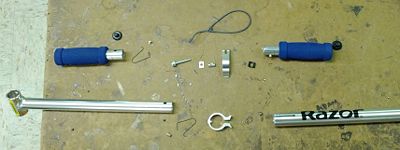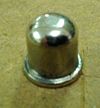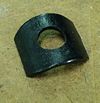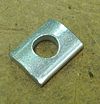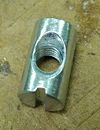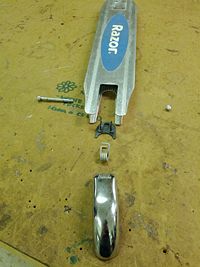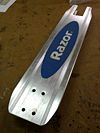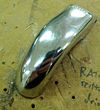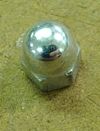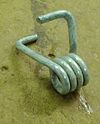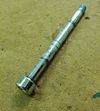Scooter
From DDL Wiki
(→Major Stakeholders) |
(→Design for Manufacturing and Assembly Analysis) |
||
| Line 961: | Line 961: | ||
=Design for Manufacturing and Assembly Analysis= | =Design for Manufacturing and Assembly Analysis= | ||
| - | Design for Manufacturing | + | ==Design for Manufacturing== |
When analyzing our competitor's product, the Razor scooter A2, we found a lot of room for improvement of its manufacturability. In order to minimize the part count, it would be possible to design a collapsing mechanism that uses fewer parts than the current design, which has 18 parts. The plastic covers especially are mostly for decoration, with a secondary purpose of preventing young children from sticking their fingers into the locking mechanism. Even so, they are not essential to the design of the collapsing subassembly, and so only add unnecessary steps to the manufacturing and assembly processes. Throughout the whole product, plastic parts were added instead of using metal finishing processes. While this was resulted in fewer finishing steps, it added steps both in manufacturing and assembly. | When analyzing our competitor's product, the Razor scooter A2, we found a lot of room for improvement of its manufacturability. In order to minimize the part count, it would be possible to design a collapsing mechanism that uses fewer parts than the current design, which has 18 parts. The plastic covers especially are mostly for decoration, with a secondary purpose of preventing young children from sticking their fingers into the locking mechanism. Even so, they are not essential to the design of the collapsing subassembly, and so only add unnecessary steps to the manufacturing and assembly processes. Throughout the whole product, plastic parts were added instead of using metal finishing processes. While this was resulted in fewer finishing steps, it added steps both in manufacturing and assembly. | ||
| Line 976: | Line 976: | ||
| - | Design for Assembly | + | ==Design for Assembly== |
Our product was fairly complicated to disassemble, and in our limited experience attempting to reassemble some of its subassemblies, we discovered much room for improvement in its design. First of all, there were a lot of components for such a small, simple device. Some of these were flashy add-ons for marketing and design purposes, such as the shocks and wheelie bar, but others were useless or not essential to the function of the device, such as the numerous plastic pieces used as covers to hide unfinished parts. As well as removing unnecessary components, another way to minimize the part count is to remove fasteners, and utilize snap fitting or other means of attachment. A lot of screws were used in this device, and as we've discussed, they were already a hindrance for a number of other reasons. | Our product was fairly complicated to disassemble, and in our limited experience attempting to reassemble some of its subassemblies, we discovered much room for improvement in its design. First of all, there were a lot of components for such a small, simple device. Some of these were flashy add-ons for marketing and design purposes, such as the shocks and wheelie bar, but others were useless or not essential to the function of the device, such as the numerous plastic pieces used as covers to hide unfinished parts. As well as removing unnecessary components, another way to minimize the part count is to remove fasteners, and utilize snap fitting or other means of attachment. A lot of screws were used in this device, and as we've discussed, they were already a hindrance for a number of other reasons. | ||
Revision as of 03:29, 8 February 2012
Group Information
24-441 Spring 2012, Group 10
Product: Razor Scooter
Executive Summary
A kick scooter is a simple human-powered vehicle, composed of a small platform to stand on and handle bars to hold onto and steer, used as a means of transportation over short distances. As a case study, our team is analyzing the Razor brand scooter, one of the most popular in the United States. The scooter will be disassembled in order to gain an understanding of how it is manufactured and put together. Competitor products will also be examined in order to understand various solutions the manufacturers face. An initial user study will be conducted to determine shortcomings in the overall design. The goal of the project is to come up with an innovation to make the scooter easier or safer to use, to make the construction simpler, or to change its purpose by adding a utility attachment.
Major Stakeholders
Manufacturing
- Simple parts that can be mass produced
- Small number of unique parts
- Assembly with minimal effort
- Fast assembly time
- Environmental effect of materials used
- Product re-usability
Shipping
- Maximum compressibility
- Low weight
- Low volume
- Reduce empty/wasted space
- Durable enough to withstand damage with minimal padding
Retailers
- Appealing colors to customers
- Cheap product cost for maximal profit
- Minimal store floor-space usage
- Efficient packaging for minimal storage space
Potential Consumers and their concerns
Parents
- Low cost
- Reliable
- Safe
- Durable
- Something their kids will want and think is cool
Kids
- Fun
- Cool
- Light weight
- Trick friendly
College Students
- Portable
- Collapsible
- Light weight
- Easy to carry/store
- Energy efficient
- Cheap
- Durable
Product Details and Observations
Product Operation and Preliminary User Study
Potential Innovations
Bill of Materials
In order to make the BOM more comprehensible, it is split up into separate subassembly BOMs. Repeating components share the same part number across subassemblies.
Front Wheel Subassembly
Shock and Wheel Attachment Subassembly
Lower Tube Subassembly
Collapsing Mechanism Subassembly
Front Deck Subassembly
Rear Wheel Subassembly
Top Tube Subassembly
| Part No. | Part Name | Material | Quantity | Function | Weight (oz) | Dimensions | Manufacturing Process | Picture |
|---|---|---|---|---|---|---|---|---|
| 46 | Bottom Tube | Steel | 1 | 5.1 | Extruded and Machined | 
| ||
| 47 | Top Tube | Steel | 1 | 4.8 | Extruded, Welded, Machined | 
|
Handle Bar Subassembly
Top Tube Adjustment Subassembly
Frame and Brake Subassembly
Design for Manufacturing and Assembly Analysis
Design for Manufacturing
When analyzing our competitor's product, the Razor scooter A2, we found a lot of room for improvement of its manufacturability. In order to minimize the part count, it would be possible to design a collapsing mechanism that uses fewer parts than the current design, which has 18 parts. The plastic covers especially are mostly for decoration, with a secondary purpose of preventing young children from sticking their fingers into the locking mechanism. Even so, they are not essential to the design of the collapsing subassembly, and so only add unnecessary steps to the manufacturing and assembly processes. Throughout the whole product, plastic parts were added instead of using metal finishing processes. While this was resulted in fewer finishing steps, it added steps both in manufacturing and assembly.
The Razor scooter we disassembled also showed opportunities to standardize components, commonize the product line, and standardize design features. A lot of the screws used as fasteners were the same size, but several differed by one size, and a few even switched from Imperial to Metric sizing. By unifying the size and length of screws used, the scooter could take better advantage of economies of scale and utilize fewer tools in the manufacturing process.
Another area for possible improvement with respect to design for manufacture is the creation of multifunctional parts. No parts of the scooter are currently multifunctional, but there is a definite opportunity for the creation of such parts in our redesign. For instance, designing a brake that doubled as a lock for the handlebars when the scooter is in its collapsed position could remove the hassle of the handlebars swinging about loosely when unlocked.
A final place where manufacturability of the scooter could be improved is in its secondary & finishing operations. Every single aluminum piece that is visible on the outside of the scooter has been polished, and a sandpaper sticker was glued onto the deck when it would have been much easier and probably as effective to extend the extruded ribs across the deck of the scooter to add friction.
Despite all these areas for improvement, there were many ways the current design had kept maufacturability in mind, which we will remember as we consider our redesign. Some of the locking mechanisms on the scooter had minimized their part counts to about 2 parts (for example, the handlebar locking mechanisms each consisted of a button and a spring). Similarly, the scooter had some fairly sleek and simple designs, like the braking mechanism which, while not 100% functional, also only consisted of about 4 parts. In terms of ease of fabrication, most of the scooter was made of aluminum, which is easy to manufacture (when the aluminum is recycled) and very easy to machine. Most parts that were not aluminum were plastic, and the few remaining parts were made of steel or rubber. The plastic parts were all colored black by color dyes added to the injection molding process.
Overall, there are a few good designs we will keep in mind during our redesign, but even more opportunities for improvement which we hope to take advantage of in the next phases of our design process.
Design for Assembly
Our product was fairly complicated to disassemble, and in our limited experience attempting to reassemble some of its subassemblies, we discovered much room for improvement in its design. First of all, there were a lot of components for such a small, simple device. Some of these were flashy add-ons for marketing and design purposes, such as the shocks and wheelie bar, but others were useless or not essential to the function of the device, such as the numerous plastic pieces used as covers to hide unfinished parts. As well as removing unnecessary components, another way to minimize the part count is to remove fasteners, and utilize snap fitting or other means of attachment. A lot of screws were used in this device, and as we've discussed, they were already a hindrance for a number of other reasons.
Another area that could be improved upon is the ease of handling of parts for human assembly. There are a lot of ambiguous parts, such as screws and levers, which can be very difficult to tell apart and could easily be unified for easy assembly. Some of these parts are also symmetrical, but only work in one orientation. These parts should be made obviously unsymmetrical, so that it is obvious in which orientation they should be attached to the product. The orientation in which parts are attached is not uniform, either. Many parts have fasteners on multiple sides, and most of these are attached horizontally instead of the ideal attachment direction of straight down. A final cause for concern is that many of the parts of this scooter are assembled inside its small-diameter tubes, which are tight and do not facilitate easy movement or sight.
The main way in which the scooter utilized good design for assembly was its use of subassemblies that can be assembled and tested separately or outsourced. The wheel subassemblies are almost certainly tested and purchased separately, and most other subassemblies, such as the telescoping tubes, brake assembly, and handlebar assembly, can easily be tested without the entire product.
There are many ways to improve the ease of assembly in this product, many of which we will probably explore in the next phases of our project.
